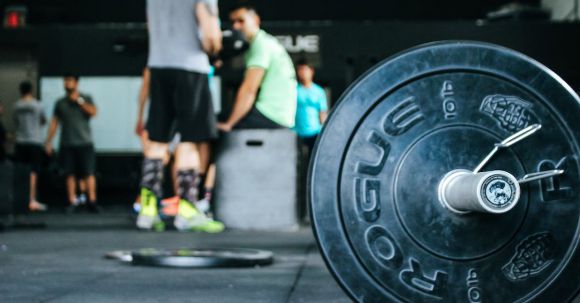Are you ready to take your fitness journey to the next level? Look no further than Fit On's Crossfit Competition. This intense and exhilarating event will challenge your strength, endurance, and mental toughness. Whether you're a seasoned Crossfit enthusiast or a beginner looking to test your limits, this competition is the perfect opportunity to push yourself and achieve new fitness goals. Get ready to crush your cardio and join the excitement!
Author: fit-on
Losing weight can be a challenging journey, but it's important to prioritize your health and approach it in a sustainable way. Crash diets and extreme exercise regimens may promise quick results, but they often lead to disappointment and can be detrimental to your overall well-being. Instead, focus on making small, realistic changes to your lifestyle that will help you lose weight in a healthy and maintainable way.
1. Set Realistic Goals
Before embarking on your weight loss journey, it's crucial to set realistic goals. Trying to lose too much weight too quickly is not only unsustainable but also unhealthy. Aim for a gradual weight loss of 1-2 pounds per week, as this is considered a safe and achievable target. Remember, slow and steady wins the race.2. Incorporate Balanced Nutrition
A key component of healthy weight loss is a balanced diet. Focus on consuming nutrient-dense foods that provide essential vitamins and minerals, while limiting your intake of processed and sugary foods. Incorporate plenty of fruits, vegetables, whole grains, lean proteins, and healthy fats into your meals. Additionally, be mindful of portion sizes to avoid overeating.3. Stay Hydrated
Drinking an adequate amount of water is often overlooked but plays a vital role in weight loss. Not only does water keep you hydrated, but it can also help regulate your appetite and boost metabolism. Make it a habit to drink at least eight glasses of water per day, and consider swapping sugary beverages for water to reduce calorie intake.4. Be Mindful of Your Eating Habits
In today's fast-paced world, it's easy to fall into unhealthy eating habits, such as mindless snacking or eating on the go. To promote healthy weight loss, practice mindful eating. Pay attention to your body's hunger and fullness cues, and eat slowly to savor your food. By being present during meals, you'll be more aware of portion sizes and make healthier choices.5. Get Moving
Regular physical activity is crucial for weight loss and overall well-being. Find activities that you enjoy, whether it's going for a walk, dancing, or taking up a new sport. Aim for at least 150 minutes of moderate-intensity exercise per week, and incorporate strength training exercises to build muscle. Remember, every little bit of movement counts, so find opportunities to be active throughout the day.6. Prioritize Sleep
Adequate sleep is often underestimated but plays a significant role in weight loss. Lack of sleep can disrupt your hormones, increase cravings, and lead to weight gain. Aim for 7-9 hours of quality sleep each night to support your weight loss efforts. Establish a consistent bedtime routine and create a sleep-friendly environment to enhance your sleep quality.7. Manage Stress
Stress can sabotage your weight loss efforts, as it often leads to emotional eating and unhealthy coping mechanisms. Find healthy ways to manage stress, such as practicing mindfulness, engaging in relaxation techniques, or pursuing hobbies you enjoy. By taking care of your mental well-being, you'll be better equipped to make healthier choices and stay on track with your weight loss goals. In conclusion, losing weight the healthy way is about making sustainable lifestyle changes. Set realistic goals, focus on balanced nutrition, stay hydrated, and be mindful of your eating habits. Incorporate regular physical activity, prioritize sleep, and manage stress effectively. Remember, healthy weight loss is a journey, not a race. By adopting these habits, you'll not only lose weight but also improve your overall health and well-being.
Maintaining a healthy weight can be a challenge, especially for busy individuals who are constantly juggling work, family, and other responsibilities. However, with the right weight loss program, it is possible to achieve your fitness goals without sacrificing your precious time. In this article, we will explore the ultimate weight loss programs for busy individuals that are effective and manageable.
1. High-Intensity Interval Training (HIIT)
HIIT is a workout method that involves short bursts of intense exercise followed by brief periods of rest or lower-intensity activity. This type of training is perfect for busy individuals as it can be completed in as little as 15-20 minutes. HIIT workouts are known to be highly effective in burning calories and increasing metabolism, even after the workout is over. Incorporating HIIT into your routine a few times a week can be a game-changer in your weight loss journey.2. Meal Prepping
Meal prepping is a great strategy for busy individuals who have limited time to cook healthy meals. By dedicating a few hours each week to prepare and portion your meals in advance, you can ensure that you have healthy and nutritious options readily available. This helps you avoid the temptation of unhealthy takeout or fast food when you are pressed for time. Additionally, meal prepping allows you to control portion sizes and track your calorie intake, which is crucial for weight loss.3. Intermittent Fasting
Intermittent fasting is a popular weight loss method that involves cycling between periods of fasting and eating. This approach can be particularly beneficial for busy individuals as it does not require any special foods or complicated meal plans. There are several different methods of intermittent fasting, such as the 16/8 method (fasting for 16 hours and eating within an 8-hour window) or the 5:2 method (eating normally for five days and restricting calorie intake for two days). It is important to consult with a healthcare professional before starting any fasting regimen.4. Incorporating Physical Activity Into Daily Routine
For busy individuals, finding time for exercise can be a challenge. However, there are various ways to incorporate physical activity into your daily routine without dedicating extra time. For example, take the stairs instead of the elevator, park your car further away from your destination and walk, or use a standing desk instead of sitting all day. These small lifestyle changes can make a big difference in burning calories and improving overall fitness.5. Mindful Eating
Mindful eating is a practice that involves paying attention to the sensations and cues of your body while eating. This means eating slowly, savoring each bite, and listening to your body's hunger and fullness signals. By being more mindful of your eating habits, you can prevent overeating and make healthier food choices. This is especially important for busy individuals who often eat on-the-go or while multitasking. In conclusion, weight loss is achievable even for busy individuals. By incorporating the above-mentioned strategies into your lifestyle, you can create an effective weight loss program that fits into your busy schedule. Remember, consistency is key, and small changes can lead to significant results over time. Prioritize your health, and you will see the benefits not only in your weight but also in your overall well-being.
Are you looking for a new challenge to take your fitness to the next level? If so, it's time to step out of your comfort zone and enter a Fit on Obstacle Course competition. This thrilling event will test your strength, endurance, and mental toughness like never before. Get ready to push your limits and experience an adrenaline rush like no other.
What is Fit on Obstacle Course?
Fit on Obstacle Course is a popular fitness event that combines running with various physical challenges. Participants must navigate through a series of obstacles, such as climbing walls, crawling under barbed wire, jumping over hurdles, and more. The course is designed to push your body to its limits and test your overall fitness level.Why should you enter?
1. Challenge yourself: If you're tired of your regular workout routine and want to challenge yourself in a new way, a Fit on Obstacle Course competition is the perfect opportunity. It will push you out of your comfort zone and force you to overcome physical and mental obstacles. 2. Full-body workout: Unlike traditional workouts that focus on specific muscle groups, obstacle courses provide a full-body workout. You'll be using your arms, legs, core, and cardiovascular system all at once. This type of functional training is not only physically demanding but also incredibly effective for overall fitness. 3. Build mental toughness: Obstacle courses require mental strength and resilience. As you face each challenge, you'll learn to overcome your fears and push through the pain. This mental toughness will not only benefit you during the competition but also in other areas of your life.Tips for preparing
1. Train for endurance: Obstacle course competitions are physically demanding, so it's important to build your endurance. Incorporate running into your training routine and gradually increase your distance and speed. This will help you maintain a steady pace throughout the course. 2. Focus on strength training: Strengthening your muscles is crucial for conquering the obstacles. Incorporate exercises such as pull-ups, push-ups, squats, and lunges into your training regimen. Don't forget to work on your grip strength as well, as this will come in handy during climbing obstacles. 3. Practice agility and balance: Obstacle courses often require quick movements and balance. Incorporate agility drills, such as ladder drills and cone drills, into your training routine. Additionally, practice balancing exercises to improve your stability and coordination. 4. Mental preparation: Obstacle courses can be mentally challenging, so it's important to prepare your mind as well. Visualize yourself successfully completing each obstacle and overcoming any challenges that may arise. Practice positive self-talk and develop a strong mindset that will carry you through the competition.Conclusion: Push Your Limits and Conquer the Course
Entering a Fit on Obstacle Course competition is not for the faint of heart. It requires dedication, perseverance, and a willingness to push your limits. But the rewards are well worth it. Not only will you experience a thrilling and adrenaline-pumping adventure, but you'll also improve your overall fitness, build mental toughness, and gain a sense of accomplishment. So, what are you waiting for? Step outside your comfort zone, train hard, and enter the Fit on Obstacle Course competition. Push your limits and prove to yourself that you're capable of achieving anything you set your mind to.
Sports-specific training is the key to unlocking your full potential as an athlete. Whether you're a professional athlete or a weekend warrior, tailoring your training to the specific demands of your chosen sport can make a world of difference in your performance. In this article, we will explore the importance of sports-specific training and provide tips on how to incorporate it into your workout routine.
Understanding the Demands of Your Sport
Before diving into sports-specific training, it's important to have a clear understanding of the demands of your sport. Each sport requires specific skills, physical attributes, and movement patterns. For example, a basketball player needs explosive power, agility, and quick reflexes, while a long-distance runner needs endurance and cardiovascular fitness. By analyzing the demands of your sport, you can identify the areas that need improvement and design a training program that targets those specific needs.Focus on Functional Movements
Sports-specific training focuses on improving the functional movements required by your sport. Functional movements are those that mimic the actions you perform during your sport. For example, a tennis player may incorporate exercises that simulate the motions of a forehand or backhand swing. By training these movements, you can improve your technique, strength, and coordination, leading to better performance on the field or court.Incorporate Sport-Specific Drills
In addition to functional movements, incorporating sport-specific drills into your training can take your performance to the next level. These drills are designed to replicate the specific situations and challenges you'll encounter during competition. For example, a soccer player may practice shooting on goal from various positions, or a golfer may work on their putting technique. By repeatedly performing these drills, you can improve your skills, build muscle memory, and develop the mental toughness needed to excel in your sport.Balance Strength and Conditioning
Sports-specific training should also include a balance of strength and conditioning exercises. Strength training helps build the muscles needed for explosive power and stability, while conditioning exercises improve cardiovascular fitness and endurance. Depending on your sport, you may need to emphasize one area more than the other. For example, a football player may focus more on strength training, while a marathon runner may prioritize conditioning. However, it's important not to neglect either aspect, as both are crucial for optimal performance.Seek Professional Guidance
To get the most out of your sports-specific training, it's beneficial to seek guidance from a professional. A qualified coach or trainer can assess your strengths and weaknesses, design a customized training program, and provide feedback and support along the way. They can also help you avoid common pitfalls and injuries associated with improper training techniques. Investing in professional guidance can significantly enhance your training and help you reach your full potential as an athlete.Stay Consistent and Patient
Sports-specific training is not a quick fix or overnight solution. It requires consistency, patience, and perseverance. It's important to stick to your training program, even when progress seems slow or setbacks occur. Remember that improvement takes time, and every small step forward brings you closer to your goals. Stay focused, stay motivated, and trust the process. In conclusion, mastering your sport requires sports-specific training. By understanding the demands of your sport, focusing on functional movements, incorporating sport-specific drills, balancing strength and conditioning, seeking professional guidance, and staying consistent and patient, you can unlock your full potential as an athlete. So, lace up your shoes, grab your gear, and get ready to take your game to the next level through sports-specific training.
Are you ready to take on the dance fitness challenge and rock the fit? Dancing is not only a fun way to get moving, but it also offers a great cardiovascular workout. Whether you're a seasoned dancer or a complete beginner, here are some tips and tricks to help you make the most out of your dance fitness challenge and achieve your fitness goals.
Choose the Right Dance Style
Before you begin your dance fitness challenge, it's important to choose a dance style that suits your interests and fitness level. There are various dance styles to choose from, such as Zumba, hip-hop, salsa, or even belly dancing. Experiment with different styles and find the one that you enjoy the most. When you're passionate about the dance style, it's easier to stay motivated and committed to your fitness goals.Warm Up and Cool Down
Just like any other workout, warming up and cooling down are essential parts of your dance fitness routine. Before you start dancing, make sure to warm up your muscles and joints with some dynamic stretches and light cardio exercises. This will help prevent injuries and prepare your body for the intense workout ahead. After you finish dancing, take some time to cool down and stretch your muscles to improve flexibility and reduce muscle soreness.Focus on Your Technique
While dance fitness is all about having fun, it's important to focus on your technique to maximize the effectiveness of your workout. Pay attention to your posture, alignment, and the execution of each movement. Engage your core muscles, maintain proper form, and follow the instructions of your dance instructor. By improving your technique, you'll not only burn more calories but also reduce the risk of injury.Challenge Yourself
To see progress and achieve your fitness goals, it's important to challenge yourself during your dance fitness workouts. Push yourself to go beyond your comfort zone, try new moves, and increase the intensity of your routines. If a particular dance routine becomes too easy, don't be afraid to level up and try something more challenging. Remember, progress happens outside of your comfort zone.Stay Hydrated
Dancing is a high-energy activity that can make you work up a sweat. It's crucial to stay hydrated throughout your dance fitness challenge. Make sure to drink plenty of water before, during, and after your workout. If you're dancing for an extended period, consider sipping on a sports drink to replenish electrolytes lost through sweat.Find a Supportive Community
One of the best ways to stay motivated and accountable during your dance fitness challenge is to find a supportive community. Join a dance fitness class, attend virtual dance sessions, or connect with fellow dancers on social media. Surrounding yourself with like-minded individuals who share similar goals can provide you with the encouragement and support you need to stay on track.Track Your Progress
Lastly, make sure to track your progress throughout your dance fitness challenge. Keep a journal or use a fitness app to record your workout sessions, track your improvements, and celebrate your achievements. By seeing how far you've come, you'll stay motivated and inspired to continue rocking the fit. In conclusion, the dance fitness challenge is a fantastic way to have fun, get moving, and achieve your fitness goals. By choosing the right dance style, focusing on your technique, challenging yourself, staying hydrated, finding a supportive community, and tracking your progress, you'll be well on your way to rocking the fit and transforming your body through dance. So put on your dancing shoes, turn up the music, and get ready to dance your way to a healthier and fitter you!
When it comes to taking care of our mental health, we often think about therapy, medication, and self-care practices. However, one area that is often overlooked but plays a significant role in our mental well-being is nutrition. The food we consume has a direct impact on our brain function and can greatly influence our mood, cognition, and overall mental health. In this article, we will explore the connection between nutrition and mental health and discuss the importance of a balanced diet for optimal psychological well-being.
The Gut-Brain Axis: A Two-Way Relationship
Recent research has shed light on the intricate relationship between our gut and brain, known as the gut-brain axis. This bidirectional communication system allows the gut and brain to send signals to each other, influencing not only our physical health but also our mental state. The gut is home to trillions of bacteria, collectively known as the gut microbiota, which play a crucial role in digestion and nutrient absorption. These bacteria also produce neurotransmitters, such as serotonin, dopamine, and gamma-aminobutyric acid (GABA), which are essential for regulating mood and emotions.Nutrients for Mental Health
Certain nutrients have been found to have a particularly positive impact on mental health. Omega-3 fatty acids, commonly found in fatty fish like salmon and sardines, have been shown to reduce symptoms of depression and anxiety. These essential fats help maintain the integrity of brain cell membranes and promote the growth of new brain cells. Additionally, foods rich in antioxidants, such as berries, dark chocolate, and green leafy vegetables, can protect the brain from oxidative stress, which is linked to mental health disorders.The Role of Macronutrients
Macronutrients, including carbohydrates, proteins, and fats, are the building blocks of our diet. Each macronutrient plays a vital role in brain function and mental health. Carbohydrates are the brain's primary source of energy and are crucial for optimal cognitive function. Whole grains, fruits, and vegetables are excellent sources of complex carbohydrates that provide a steady release of energy throughout the day. Proteins, found in meat, fish, legumes, and dairy products, are essential for the production of neurotransmitters, which regulate mood and emotions. Healthy fats, such as those found in avocado, nuts, and olive oil, are necessary for the proper functioning of the brain and help reduce inflammation, which is often associated with mental health disorders.The Impact of Micronutrients
Micronutrients, including vitamins and minerals, are essential for maintaining good mental health. Vitamin D, often referred to as the "sunshine vitamin," is crucial for regulating mood and has been linked to symptoms of depression. Sources of vitamin D include sunlight, fatty fish, and fortified dairy products. B vitamins, particularly folate and vitamin B12, are important for the synthesis of neurotransmitters and can help alleviate symptoms of depression. Leafy greens, legumes, and fortified cereals are excellent sources of these vitamins. Minerals such as zinc, magnesium, and iron also play a role in mental health and can be found in foods like nuts, seeds, whole grains, and lean meats.The Importance of a Balanced Diet
While individual nutrients play a role in mental health, it is essential to remember that a balanced diet is the key to overall well-being. A diet rich in fruits, vegetables, whole grains, lean proteins, and healthy fats provides the necessary nutrients for optimal brain function. On the other hand, a diet high in processed foods, sugar, and unhealthy fats can negatively impact mental health and increase the risk of developing mental health disorders. In conclusion, the connection between nutrition and mental health is undeniable. The food we consume has a profound impact on our brain function and overall well-being. By prioritizing a balanced diet rich in nutrients, we can support our mental health and enhance our overall quality of life. So, let's remember to nourish our minds as well as our bodies, because good nutrition is essential for a healthy mind.
Balance is a fundamental aspect of our daily lives. It allows us to navigate through various activities, from walking and running to performing more complex movements. As we age, our balance naturally tends to decline, which can increase the risk of falls and injuries. However, there is good news – strength training can be a powerful tool in improving balance and maintaining stability.
Understanding the Role of Strength Training
Strength training, also known as resistance training or weightlifting, involves the use of external resistance to build and strengthen muscles. Traditionally, it has been associated with building muscle size and boosting overall strength. However, recent research suggests that strength training also plays a crucial role in enhancing balance and stability.Building Strong Muscles for Stability
One of the primary ways strength training improves balance is through building strong muscles. Our muscles act as the body's support system, helping to maintain proper alignment and stability. When these muscles are weak or imbalanced, it can lead to poor posture and compromised balance. By engaging in strength training exercises, we can target specific muscle groups, such as the quadriceps, hamstrings, glutes, and core, which are essential for maintaining balance. Strengthening these muscles not only helps to improve stability but also allows for better control of movements and reduces the risk of falls.Enhancing Proprioception and Body Awareness
Proprioception, or the body's ability to sense its position in space, is another critical factor in balance. Strength training can improve proprioception by challenging the body's awareness and coordination during exercises. For example, performing squats or lunges on an unstable surface, such as a balance board or Bosu ball, forces the body to engage additional muscles to maintain balance. Moreover, strength training exercises often involve multi-joint movements that require coordination between different muscle groups. This coordination helps to improve proprioception, allowing individuals to have a better sense of their body's position and movement, ultimately leading to improved balance.Preventing Muscle Loss and Osteoporosis
As we age, muscle loss, known as sarcopenia, becomes more prevalent. This loss of muscle mass can significantly impact balance and stability. Strength training not only helps to prevent muscle loss but also promotes muscle growth, even in older adults. Additionally, strength training has been shown to increase bone density, which is crucial for preventing osteoporosis, a condition characterized by weak and brittle bones. Stronger bones provide a solid foundation for better balance and reduce the risk of fractures in the event of a fall.Incorporating Strength Training into Your Routine
To reap the benefits of strength training for balance improvement, it is essential to incorporate specific exercises into your routine. Some effective strength training exercises for balance include squats, lunges, deadlifts, step-ups, and planks. It is recommended to start with lighter weights and gradually increase the resistance as you become more comfortable and confident in your abilities. It is also important to maintain proper form during strength training exercises to avoid injury. If you are unsure about proper technique, consider working with a qualified personal trainer who can guide you through the exercises and ensure you are performing them correctly.Conclusion: Reap the Benefits of Strength Training for Balance
In conclusion, strength training can be a valuable tool in improving balance and stability. By building strong muscles, enhancing proprioception, preventing muscle loss, and promoting bone density, strength training offers numerous benefits for individuals of all ages. Incorporating specific strength training exercises into your routine can help you maintain better balance, reduce the risk of falls, and improve overall stability in your daily activities. So don't wait – start strength training today and take control of your balance and well-being.
Every athlete dreams of reaching their peak performance level in their chosen sport. Whether you're a professional or an amateur, sports-specific training can be the key to unlocking your full potential. By tailoring your workouts to mimic the movements and demands of your sport, you can enhance your skills, prevent injuries, and take your performance to the next level. In this article, we will explore the benefits of sports-specific training and provide some tips on how to incorporate it into your routine.
Understanding Sports-specific Training
Sports-specific training is a targeted approach to conditioning that focuses on the specific requirements of your sport. It involves exercises and drills that closely mimic the movements, skills, and energy systems used in your chosen activity. Rather than focusing solely on general fitness or strength training, sports-specific training hones in on the specific skills and physical attributes needed for success in your sport.Benefits of Sports-specific Training
1. Enhanced Performance: By training in a way that closely mirrors the demands of your sport, you can improve your performance in key areas such as speed, agility, power, and endurance. Sports-specific exercises help to develop the specific muscle groups and movement patterns required for optimal performance. 2. Injury Prevention: One of the biggest advantages of sports-specific training is its ability to reduce the risk of injuries. By targeting the muscles and joints most susceptible to injury in your sport, you can strengthen and stabilize them, making you less prone to common injuries. Additionally, sports-specific training can help improve your balance, coordination, and proprioception, all of which play a crucial role in injury prevention.Incorporating Sports-specific Training into Your Routine
1. Identify Key Skills: Start by identifying the key skills and movements required in your sport. Is it speed and agility, power and explosiveness, or endurance and stamina? Understanding the specific demands of your sport will help you tailor your training accordingly. 2. Mimic Sport-specific Movements: Once you've identified the key skills, design exercises and drills that closely mimic the movements involved. For example, if you're a tennis player looking to improve your forehand, practice shadow swings and footwork drills that simulate game-like situations. 3. Train Energy Systems: Different sports rely on different energy systems. For example, endurance sports like long-distance running primarily utilize the aerobic energy system, while explosive sports like sprinting rely on the anaerobic energy system. Incorporate exercises that target the specific energy systems used in your sport to improve your overall performance. 4. Periodization: To maximize the benefits of sports-specific training, incorporate periodization into your routine. Periodization involves dividing your training program into specific phases, each with a different focus. This allows for proper recovery, prevents overtraining, and ensures continued progress over time.Conclusion: Unleash Your Full Potential
Sports-specific training is a game-changer when it comes to improving your performance in your chosen sport. By tailoring your workouts to mimic the movements and demands of your sport, you can enhance your skills, prevent injuries, and unleash your full potential. Remember to identify the key skills, mimic sport-specific movements, train energy systems, and incorporate periodization into your routine. With dedication and consistency, sports-specific training can take your performance to new heights. So, lace up your shoes, grab your equipment, and get ready to excel like never before!
In today's fast-paced world, finding time to hit the gym can be a challenge. Between work, family, and other commitments, it often feels like there just aren't enough hours in the day. However, thanks to the rise of online personal training, getting fit has never been more convenient. With online personal training, you can work out whenever and wherever you want, making it the perfect solution for busy individuals looking to prioritize their health and fitness goals.









